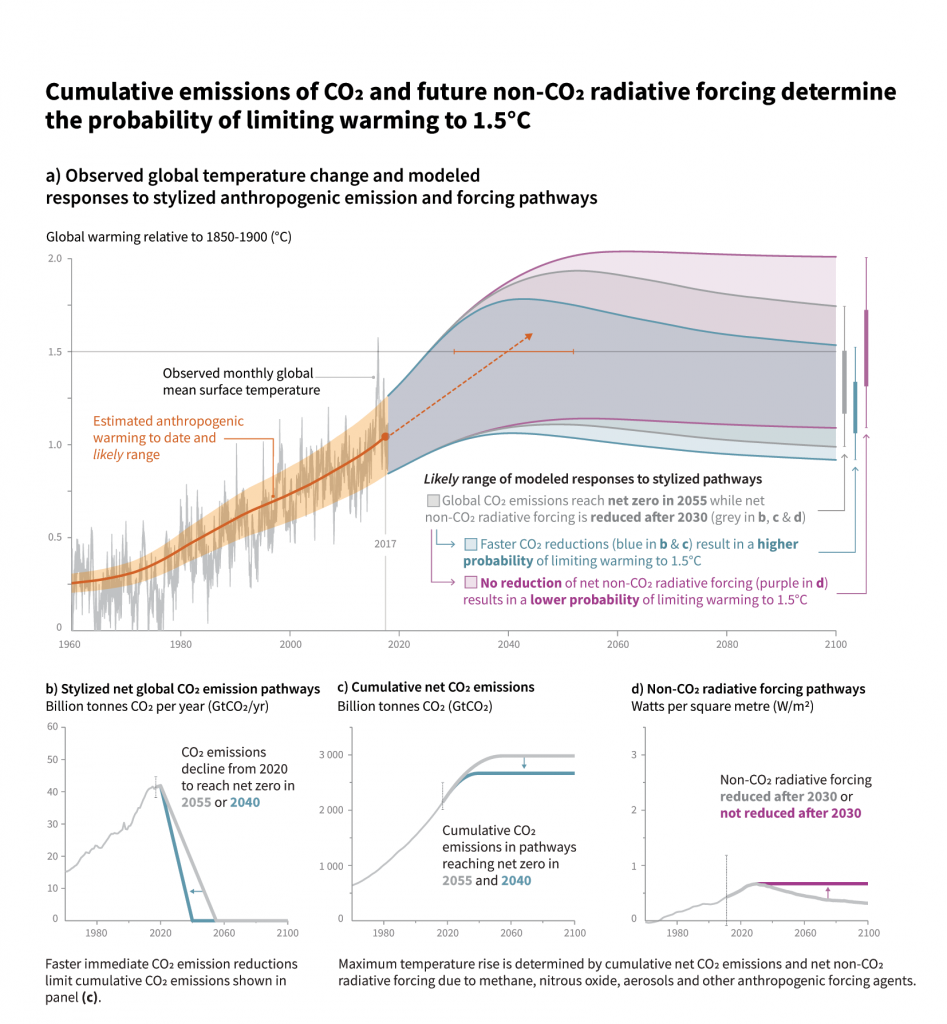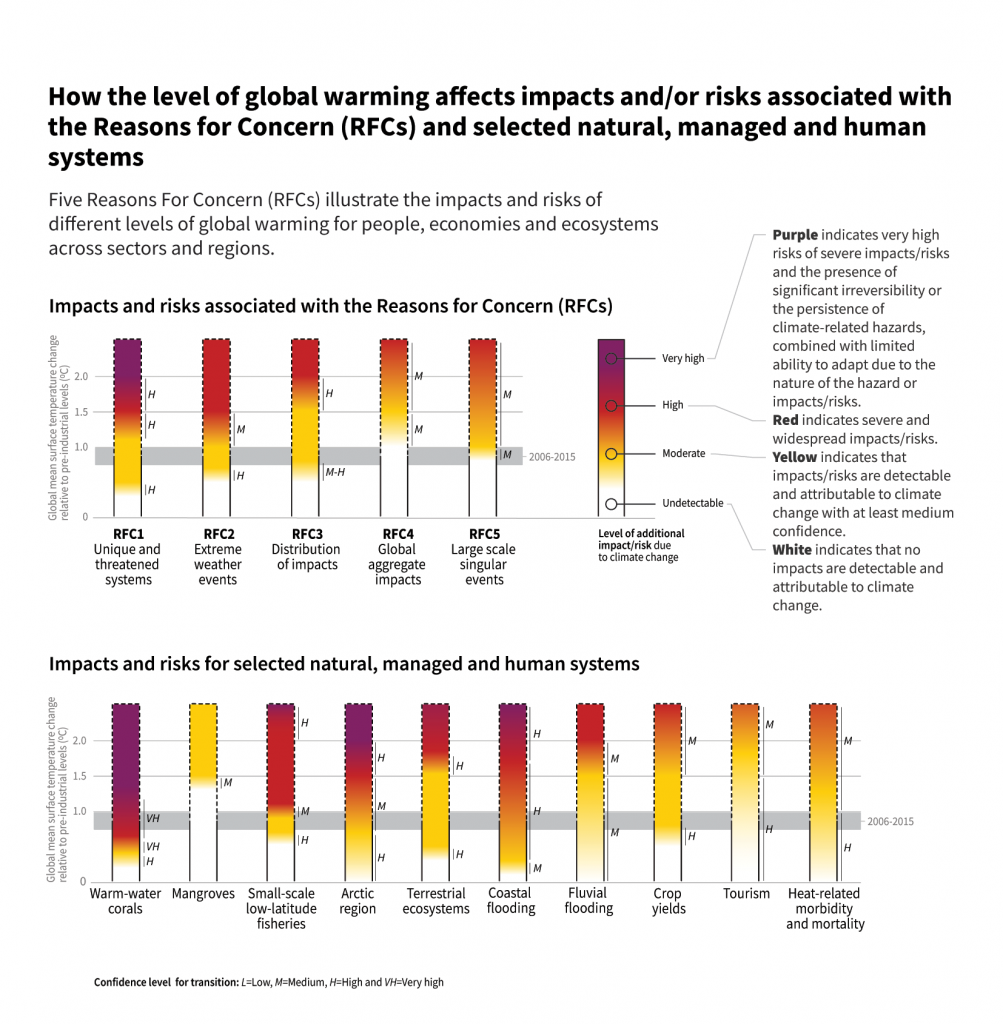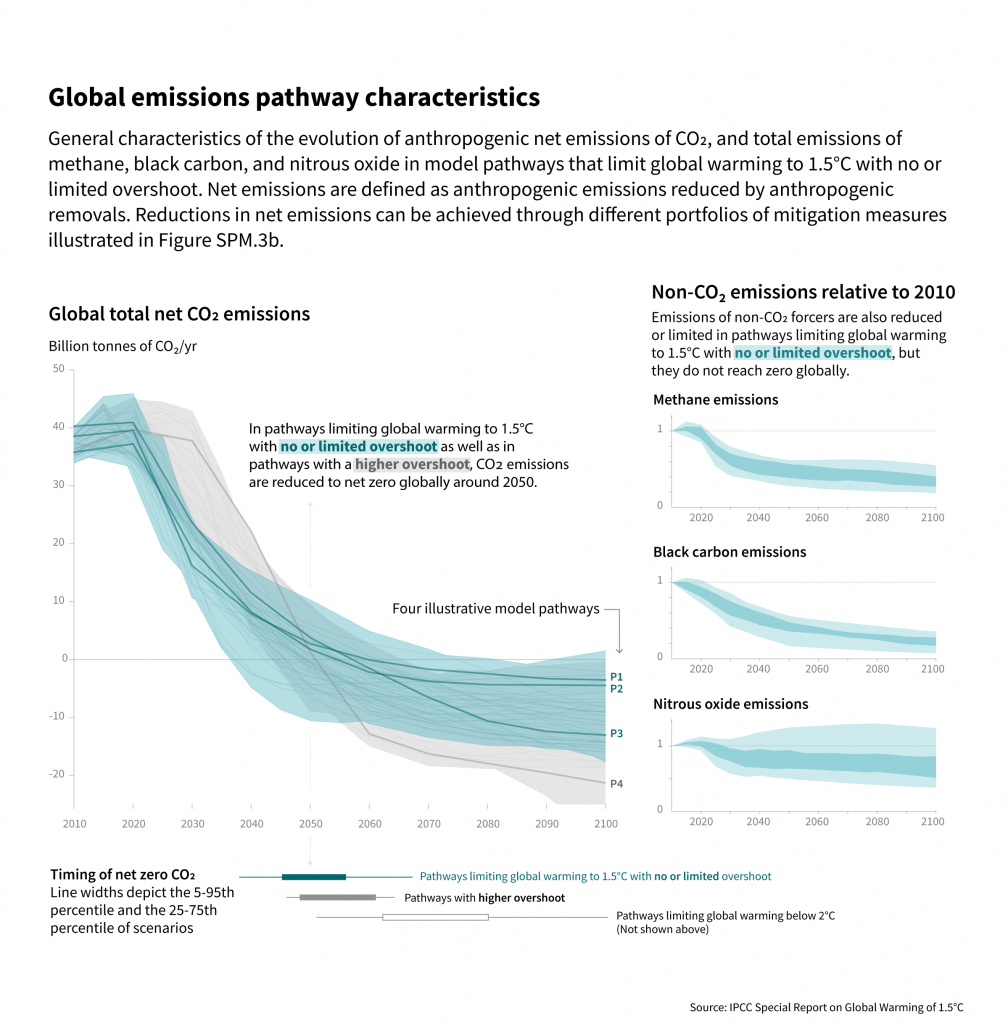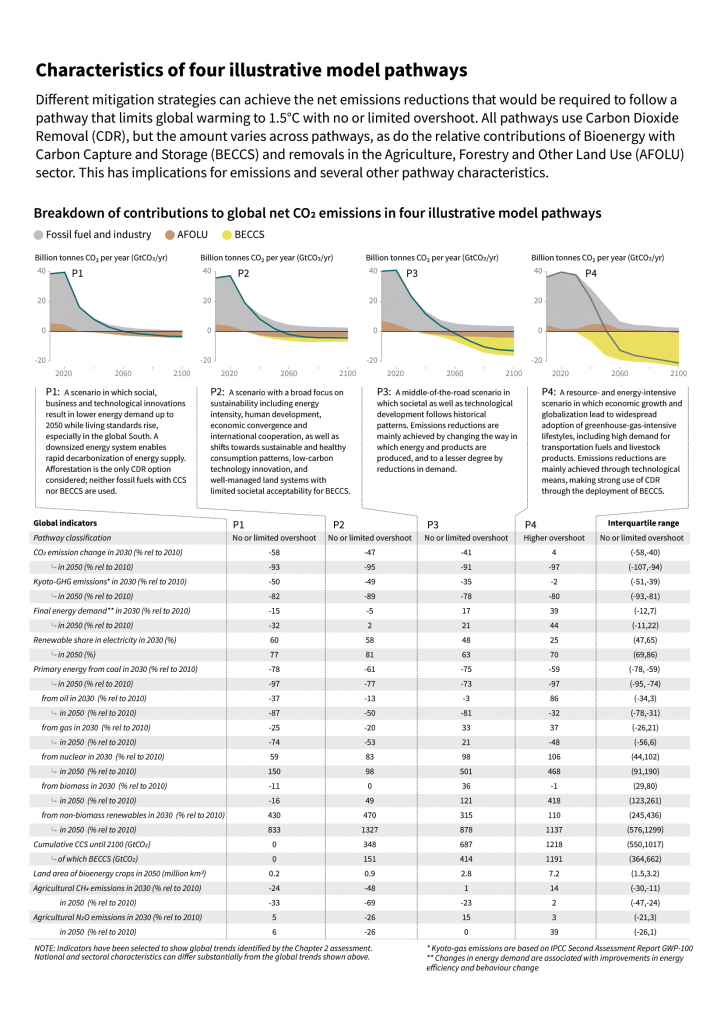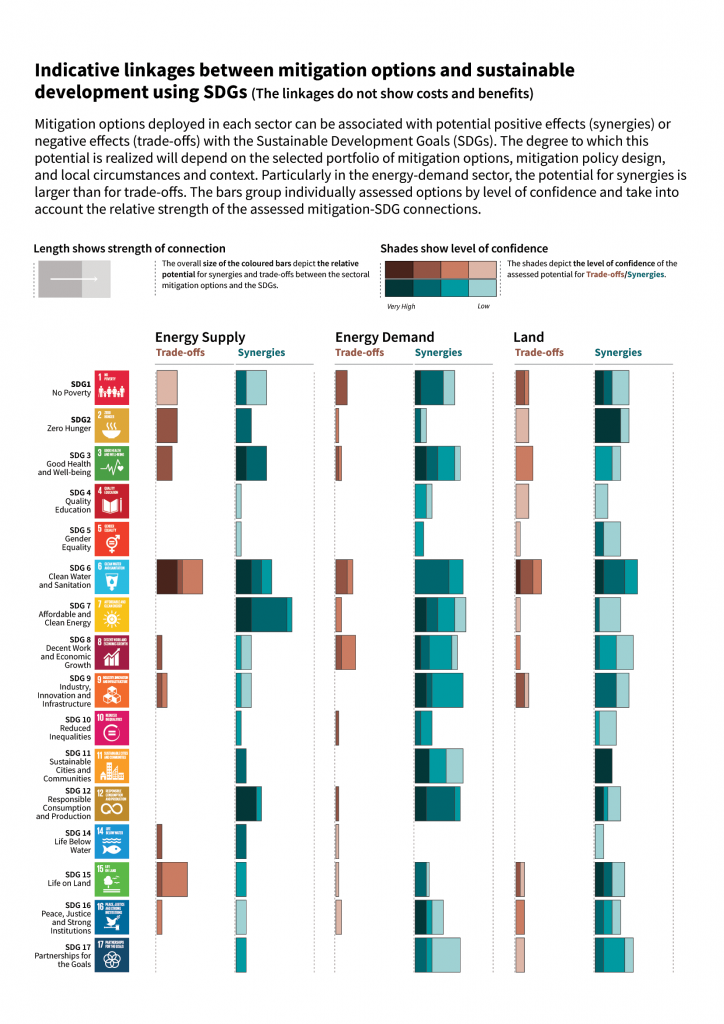B.1. Climate models project robust differences in regional climate characteristics between present-day and global warming of 1.5°C,and between 1.5°C and 2°C. These differences include increases in: mean temperature in most land and ocean regions (high confidence), hot extremes in most inhabited regions (high confidence), heavy precipitation in several regions (medium confidence), and the probability of drought and precipitation deficits in some regions (medium confidence). {3.3}
B.1.1. Evidence from attributed changes in some climate and weather extremes for a global warming of about 0.5°C supports the assessment that an additional 0.5°C of warming compared to present is associated with further detectable changes in these extremes (medium confidence). Several regional changes in climate are assessed to occur with global warming up to 1.5°C compared to pre-industrial levels, including warming of extreme temperatures in many regions (high confidence), increases in frequency, intensity, and/or amount of heavy precipitation in several regions (high confidence), and an increase in intensity or frequency of droughts in some regions (medium confidence). {3.2, 3.3.1, 3.3.2, 3.3.3, 3.3.4, Table 3.2}
B.1.2. Temperature extremes on land are projected to warm more than GMST (high confidence): extreme hot days in mid-latitudes warm by up to about 3°C at global warming of 1.5°C and about 4°C at 2°C, and extreme cold nights in high latitudes warm by up to about 4.5°C at 1.5°C and about 6°C at 2°C (high confidence). The number of hot days is projected to increase in most land regions, with highest increases in the tropics (high confidence). {3.3.1, 3.3.2, Cross-Chapter Box 8 in Chapter 3}
B.1.3. Risks from droughts and precipitation deficits are projected to be higher at 2°C compared to 1.5°C of global warming in some regions (medium confidence). Risks from heavy precipitation events are projected to be higher at 2°C compared to 1.5°C of global warming in several northern hemisphere high-latitude and/or high-elevation regions, eastern Asia and eastern North America (medium confidence). Heavy precipitation associated with tropical cyclones is projected to be higher at 2°C compared to 1.5°C global warming (medium confidence). There is generally low confidence in projected changes in heavy precipitation at 2°C compared to 1.5°C in other regions. Heavy precipitation when aggregated at global scale is projected to be higher at 2°C than at 1.5°C of global warming (medium confidence). As a consequence of heavy precipitation, the fraction of the global land area affected by flood hazards is projected to be larger at 2°C compared to 1.5°C of global warming (medium confidence). {3.3.1, 3.3.3, 3.3.4, 3.3.5, 3.3.6}
B.2. By 2100, global mean sea level rise is projected to be around 0.1 metre lower with global warming of 1.5°C compared to 2°C (medium confidence). Sea level will continue to rise well beyond 2100 (high confidence), and the magnitude and rate of this rise depend on future emission pathways. A slower rate of sea level rise enables greater opportunities for adaptation in the human and ecological systems of small islands, low-lying coastal areas and deltas (medium confidence). {3.3, 3.4, 3.6}
B.2.1. Model-based projections of global mean sea level rise (relative to 1986–2005) suggest an indicative range of 0.26 to 0.77 m by 2100 for 1.5°C of global warming, 0.1 m (0.04–0.16 m) less than for a global warming of 2°C (medium confidence). A reduction of 0.1 m in global sea level rise implies that up to 10 million fewer people would be exposed to related risks, based on population in the year 2010 and assuming no adaptation (medium confidence). {3.4.4, 3.4.5, 4.3.2}
B.2.2. Sea level rise will continue beyond 2100 even if global warming is limited to 1.5°C in the 21st century (high confidence). Marine ice sheet instability in Antarctica and/or irreversible loss of the Greenland ice sheet could result in multi-metre rise in sea level over hundreds to thousands of years. These instabilities could be triggered at around 1.5°C to 2°C of global warming (medium confidence). (Figure SPM.2) {3.3.9, 3.4.5, 3.5.2, 3.6.3, Box 3.3}
B.2.3. Increasing warming amplifies the exposure of small islands, low-lying coastal areas and deltas to the risks associated with sea level rise for many human and ecological systems, including increased saltwater intrusion, flooding and damage to infrastructure (high confidence). Risks associated with sea level rise are higher at 2°C compared to 1.5°C. The slower rate of sea level rise at global warming of 1.5°C reduces these risks, enabling greater opportunities for adaptation including managing and restoring natural coastal ecosystems and infrastructure reinforcement (medium confidence). (Figure SPM.2) {3.4.5, Box 3.5}
B.3. On land, impacts on biodiversity and ecosystems, including species loss and extinction, are projected to be lower at 1.5°C of global warming compared to 2°C. Limiting global warming to 1.5°C compared to 2°C is projected to lower the impacts on terrestrial, freshwater and coastal ecosystems and to retain more of their services to humans (high confidence). (Figure SPM.2) {3.4, 3.5, Box 3.4, Box 4.2, Cross-Chapter Box 8 in Chapter 3}
B.3.1. Of 105,000 species studied, 6% of insects, 8% of plants and 4% of vertebrates are projected to lose over half of their climatically determined geographic range for global warming of 1.5°C, compared with 18% of insects, 16% of plants and 8% of vertebrates for global warming of 2°C (medium confidence). Impacts associated with other biodiversity-related risks such as forest fires and the spread of invasive species are lower at 1.5°C compared to 2°C of global warming (high confidence). {3.4.3, 3.5.2}
B.3.2. Approximately 4% (interquartile range 2–7%) of the global terrestrial land area is projected to undergo a transformation of ecosystems from one type to another at 1°C of global warming, compared with 13% (interquartile range 8–20%) at 2°C (medium confidence). This indicates that the area at risk is projected to be approximately 50% lower at 1.5°C compared to 2°C (medium confidence). {3.4.3.1, 3.4.3.5}
B.3.3. High-latitude tundra and boreal forests are particularly at risk of climate change-induced degradation and loss, with woody shrubs already encroaching into the tundra (high confidence) and this will proceed with further warming. Limiting global warming to 1.5°C rather than 2°C is projected to prevent the thawing over centuries of a permafrost area in the range of 1.5 to 2.5 million km2 (medium confidence). {3.3.2, 3.4.3, 3.5.5}
B.4. Limiting global warming to 1.5°C compared to 2ºC is projected to reduce increases in ocean temperature as well as associated increases in ocean acidity and decreases in ocean oxygen levels (high confidence). Consequently, limiting global warming to 1.5°C is projected to reduce risks to marine biodiversity, fisheries, and ecosystems, and their functions and services to humans, as illustrated by recent changes to Arctic sea ice and warm-water coral reef ecosystems (high confidence). {3.3, 3.4, 3.5, Box 3.4, Box 3.5}
B.4.1. There is high confidence that the probability of a sea ice-free Arctic Ocean during summer is substantially lower at global warming of 1.5°C when compared to 2°C. With 1.5°C of global warming, one sea ice-free Arctic summer is projected per century. This likelihood is increased to at least one per decade with 2°C global warming. Effects of a temperature overshoot are reversible for Arctic sea ice cover on decadal time scales (high confidence). {3.3.8, 3.4.4.7}
B.4.2. Global warming of 1.5°C is projected to shift the ranges of many marine species to higher latitudes as well as increase the amount of damage to many ecosystems. It is also expected to drive the loss of coastal resources and reduce the productivity of fisheries and aquaculture (especially at low latitudes). The risks of climate-induced impacts are projected to be higher at 2°C than those at global warming of 1.5°C (high confidence). Coral reefs, for example, are projected to decline by a further 70–90% at 1.5°C (high confidence) with larger losses (>99%) at 2ºC (very high confidence). The risk of irreversible loss of many marine and coastal ecosystems increases with global warming, especially at 2°C or more (high confidence). {3.4.4, Box 3.4}
B.4.3. The level of ocean acidification due to increasing CO2 concentrations associated with global warming of 1.5°C is projected to amplify the adverse effects of warming, and even further at 2°C, impacting the growth, development, calcification, survival, and thus abundance of a broad range of species, for example, from algae to fish (high confidence). {3.3.10, 3.4.4}
B.4.4. Impacts of climate change in the ocean are increasing risks to fisheries and aquaculture via impacts on the physiology, survivorship, habitat, reproduction, disease incidence, and risk of invasive species (medium confidence) but are projected to be less at 1.5ºC of global warming than at 2ºC. One global fishery model, for example, projected a decrease in global annual catch for marine fisheries of about 1.5 million tonnes for 1.5°C of global warming compared to a loss of more than 3 million tonnes for 2°C of global warming (medium confidence). {3.4.4, Box 3.4}
B.5. Climate-related risks to health, livelihoods, food security, water supply, human security, and economic growth are projected to increase with global warming of 1.5°C and increase further with 2°C. (Figure SPM.2) {3.4, 3.5, 5.2, Box 3.2, Box 3.3, Box 3.5, Box 3.6, Cross-Chapter Box 6 in Chapter 3, Cross-Chapter Box 9 in Chapter 4, Cross-Chapter Box 12 in Chapter 5, 5.2}
B.5.1. Populations at disproportionately higher risk of adverse consequences with global warming of 1.5°C and beyond include disadvantaged and vulnerable populations, some indigenous peoples, and local communities dependent on agricultural or coastal livelihoods (high confidence). Regions at disproportionately higher risk include Arctic ecosystems, dryland regions, small island developing states, and Least Developed Countries (high confidence). Poverty and disadvantage are expected to increase in some populations as global warming increases; limiting global warming to 1.5°C, compared with 2°C, could reduce the number of people both exposed to climate-related risks and susceptible to poverty by up to several hundred million by 2050 (medium confidence). {3.4.10, 3.4.11, Box 3.5, Cross-Chapter Box 6 in Chapter 3, Cross-Chapter Box 9 in Chapter 4, Cross-Chapter Box 12 in Chapter 5, 4.2.2.2, 5.2.1, 5.2.2, 5.2.3, 5.6.3}
B.5.2. Any increase in global warming is projected to affect human health, with primarily negative consequences (high confidence). Lower risks are projected at 1.5°C than at 2°C for heat-related morbidity and mortality (very high confidence) and for ozone-related mortality if emissions needed for ozone formation remain high (high confidence). Urban heat islands often amplify the impacts of heatwaves in cities (high confidence). Risks from some vector-borne diseases, such as malaria and dengue fever, are projected to increase with warming from 1.5°C to 2°C, including potential shifts in their geographic range (high confidence). {3.4.7, 3.4.8, 3.5.5.8}
B.5.3. Limiting warming to 1.5°C compared with 2°C is projected to result in smaller net reductions in yields of maize, rice, wheat, and potentially other cereal crops, particularly in sub-Saharan Africa, Southeast Asia, and Central and South America, and in the CO2-dependent nutritional quality of rice and wheat (high confidence). Reductions in projected food availability are larger at 2°C than at 1.5°C of global warming in the Sahel, southern Africa, the Mediterranean, central Europe, and the Amazon (medium confidence). Livestock are projected to be adversely affected with rising temperatures, depending on the extent of changes in feed quality, spread of diseases, and water resource availability (high confidence). {3.4.6, 3.5.4, 3.5.5, Box 3.1, Cross-Chapter Box 6 in Chapter 3, Cross-Chapter Box 9 in Chapter 4}
B.5.4. Depending on future socio-economic conditions, limiting global warming to 1.5°C compared to 2°C may reduce the proportion of the world population exposed to a climate change-induced increase in water stress by up to 50%, although there is considerable variability between regions (medium confidence). Many small island developing states could experience lower water stress as a result of projected changes in aridity when global warming is limited to 1.5°C, as compared to 2°C (medium confidence). {3.3.5, 3.4.2, 3.4.8, 3.5.5, Box 3.2, Box 3.5, Cross-Chapter Box 9 in Chapter 4}
B.5.5. Risks to global aggregated economic growth due to climate change impacts are projected to be lower at 1.5°C than at 2°C by the end of this century (medium confidence). This excludes the costs of mitigation, adaptation investments and the benefits of adaptation. Countries in the tropics and Southern Hemisphere subtropics are projected to experience the largest impacts on economic growth due to climate change should global warming increase from 1.5°C to 2°C (medium confidence). {3.5.2, 3.5.3}
B.5.6. Exposure to multiple and compound climate-related risks increases between 1.5°C and 2°C of global warming, with greater proportions of people both so exposed and susceptible to poverty in Africa and Asia (high confidence). For global warming from 1.5°C to 2°C, risks across energy, food, and water sectors could overlap spatially and temporally, creating new and exacerbating current hazards, exposures, and vulnerabilities that could affect increasing numbers of people and regions (medium confidence). {Box 3.5, 3.3.1, 3.4.5.3, 3.4.5.6, 3.4.11, 3.5.4.9}
B.5.7. There are multiple lines of evidence that since AR5 the assessed levels of risk increased for four of the five Reasons for Concern (RFCs) for global warming to 2°C (high confidence). The risk transitions by degrees of global warming are now: from high to very high risk between 1.5°C and 2°C for RFC1 (Unique and threatened systems) (high confidence); from moderate to high risk between 1°C and 1.5°C for RFC2 (Extreme weather events) (medium confidence); from moderate to high risk between 1.5°C and 2°C for RFC3 (Distribution of impacts) (high confidence); from moderate to high risk between 1.5°C and 2.5°C for RFC4 (Global aggregate impacts) (medium confidence); and from moderate to high risk between 1°C and 2.5°C for RFC5 (Large-scale singular events) (medium confidence). (Figure SPM.2) {3.4.13; 3.5, 3.5.2}
B.6. Most adaptation needs will be lower for global warming of 1.5°C compared to 2°C (high confidence). There are a wide range of adaptation options that can reduce the risks of climate change (high confidence). There are limits to adaptation and adaptive capacity for some human and natural systems at global warming of 1.5°C, with associated losses (medium confidence). The number and availability of adaptation options vary by sector (medium confidence). {Table 3.5, 4.3, 4.5, Cross-Chapter Box 9 in Chapter 4, Cross-Chapter Box 12 in Chapter 5}
B.6.1. A wide range of adaptation options are available to reduce the risks to natural and managed ecosystems (e.g., ecosystem-based adaptation, ecosystem restoration and avoided degradation and deforestation, biodiversity management, sustainable aquaculture, and local knowledge and indigenous knowledge), the risks of sea level rise (e.g., coastal defence and hardening), and the risks to health, livelihoods, food, water, and economic growth, especially in rural landscapes (e.g., efficient irrigation, social safety nets, disaster risk management, risk spreading and sharing, and community-based adaptation) and urban areas (e.g., green infrastructure, sustainable land use and planning, and sustainable water management) (medium confidence). {4.3.1, 4.3.2, 4.3.3, 4.3.5, 4.5.3, 4.5.4, 5.3.2, Box 4.2, Box 4.3, Box 4.6, Cross-Chapter Box 9 in Chapter 4}.
B.6.2. Adaptation is expected to be more challenging for ecosystems, food and health systems at 2°C of global warming than for 1.5°C (medium confidence). Some vulnerable regions, including small islands and Least Developed Countries, are projected to experience high multiple interrelated climate risks even at global warming of 1.5°C (high confidence). {3.3.1, 3.4.5, Box 3.5, Table 3.5, Cross-Chapter Box 9 in Chapter 4, 5.6, Cross-Chapter Box 12 in Chapter 5, Box 5.3}
B.6.3. Limits to adaptive capacity exist at 1.5°C of global warming, become more pronounced at higher levels of warming and vary by sector, with site-specific implications for vulnerable regions, ecosystems and human health (medium confidence). {Cross-Chapter Box 12 in Chapter 5, Box 3.5, Table 3.5}
